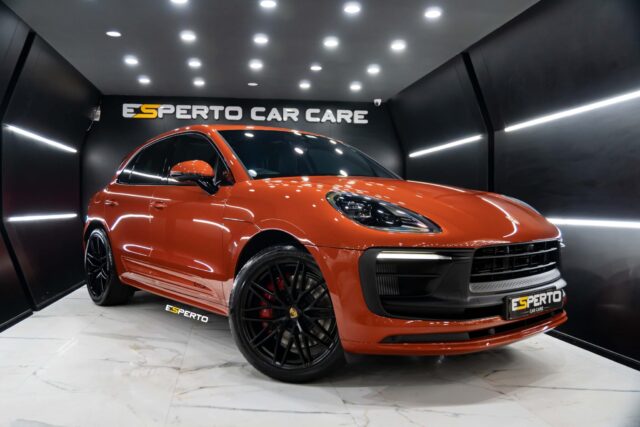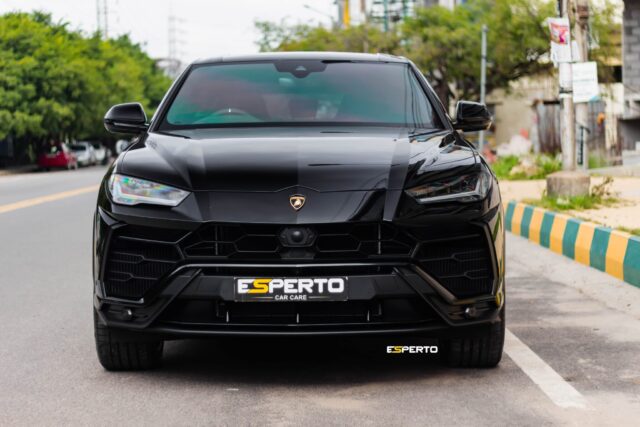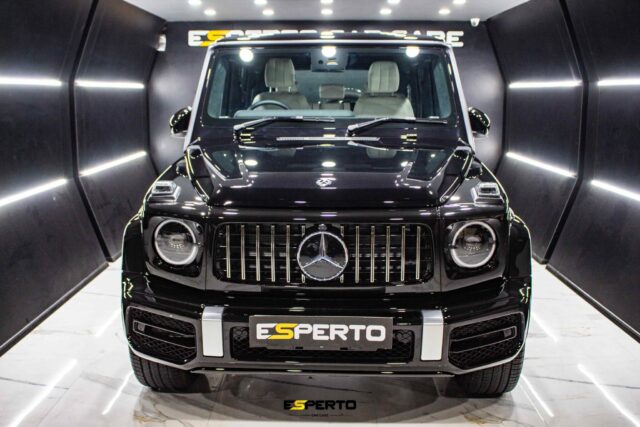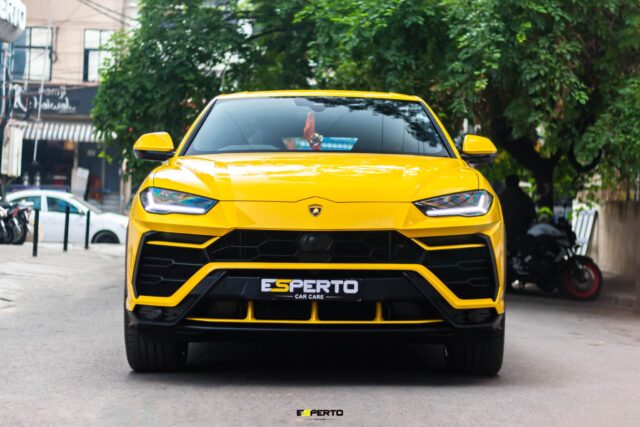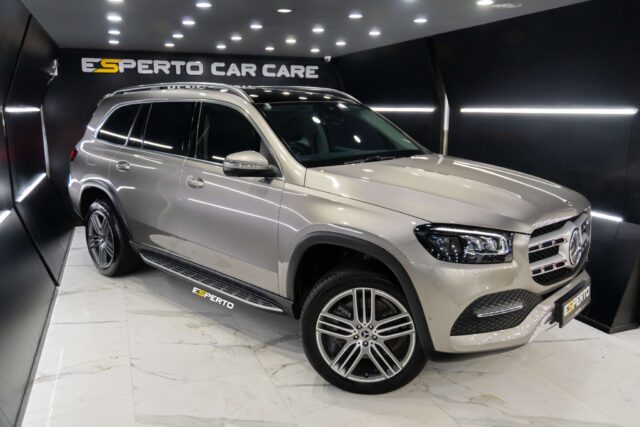Everything You Need to Know About Car Wraps: A Comprehensive Guide
Car owners often look for ways to stand out or protect their cars’ paint. If you’re wondering, “What are car wraps?” You’re not alone. A car wrap uses a special vinyl film applied to the exterior of your vehicle.
It can change your car’s appearance without damaging the original paintwork.
Our article explains everything you need to know about car wrapping, including its pros and cons, how it compares to PPF coating service for luxury cars, and what goes into choosing and applying a wrap.
We also cover how to maintain a wrapped car, so it lasts longer. Ready for a new look?
What is a Car Wrap, and How Does it Work?
A car wrap involves applying a vinyl film to the exterior of a vehicle. This process transforms its appearance without needing paint. Specialists use a heat gun to mold the vinyl around every curve and corner of the car, ensuring a smooth, seamless look.
Vinyl comes in various finishes, such as gloss, matte, or even textured options like carbon fiber.
This wrapping technique acts as a protective layer over the car’s paint. It shields the body from scratches and minor dents that occur from everyday use. Owners choose wraps to personalize their cars and advertise businesses with their custom graphics and wrap graphics.
The right type of car wrap can significantly change the appearance of your vehicle while adding an extra layer of protection against environmental damage.
What does a car wrap involve?
Car wrapping employs a vinyl coating to cover the entirety of a vehicle’s surface. This method brings about a significant transformation in the car’s visuals while preserving the car’s color and damaging the initial paint job.
Vinyl wraps are available in a wide array of colors and finishes, providing opportunities for car owners to individualize their vehicles. Tools like heat guns and squeegees help achieve smooth wrap application, eliminating any chance of air bubbles or wrinkles compromising the vehicle’s appearance. However, if imperfections do occur, knowing how to properly fix car wrap bubbles can help restore a flawless finish without damaging the vinyl or the paint underneath.
The installation process begins with a comprehensive cleaning of the car’s exterior to eradicate any traces of dirt or debris. Following this, experts take precise measurements and cut the vinyl to make it suitable for each part of the vehicle, including intricate details like door handles and curves.
To apply the vinyl film, a heat gun is used to make it flexible enough to conform to the body’s surface. The precision needed in this careful process ensures complete and even coverage of the car, resulting in a perfect finish.
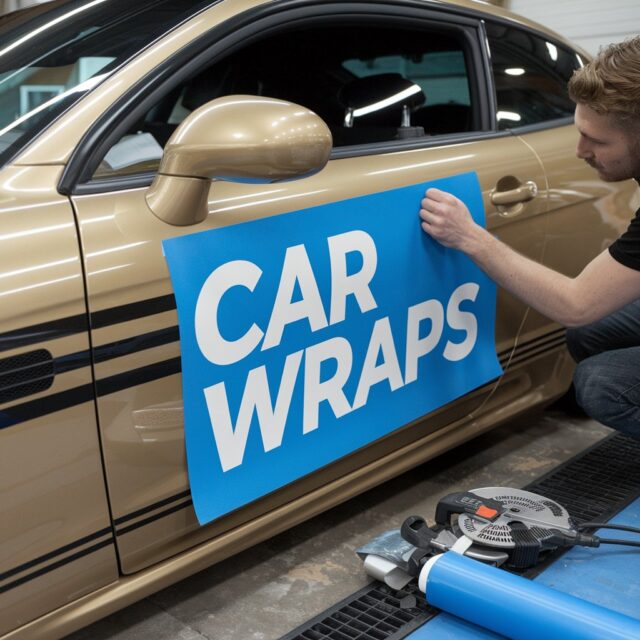
How does a car wrap work?
A car wrap involves applying a vinyl film over the entire front, wrapping a car or just parts of it to change its appearance. This process starts with a thorough cleaning of the vehicle’s exterior to ensure that no dirt interferes with the adhesive.
Professionals then measure and cut the high-quality vinyl, customizing it to fit every curve and edge of the car. They use a heat gun to carefully apply and smooth out the film, avoiding air bubbles or wrinkles.
The heat also activates the adhesive on the body surface of the vinyl, making it cling tightly to the body surface.
Car wrapping gives your vehicle a new look without having to repaint it.
This method allows for complete customization, offering different textures like metallic finishes or matte colors that can make your vehicle stand out. Next, let’s explore what makes up this versatile material known as vinyl film and how it adheres so well to cars.
What is vinyl film, and how is it applied to a car?
Shifting from how car wraps work to understanding the materials used, vinyl film stands central in this process. Vinyl film is a durable and flexible material that experts apply over a car’s exterior to change its appearance or protect its original paint.
This particular kind of film can also act as a protective cover against minor scratches and UV rays.
Professionals start applying the vinyl film by cleaning the vehicle thoroughly to ensure there are no contaminants on the car wash and surface. They then carefully place the vinyl over sections of the car wash, using tools like squeegees to smooth out bubbles and wrinkles, ensuring it adheres appropriately without damaging the car’s paint underneath.
Heat guns help mold the film around curves and edges, creating a seamless finish that looks as if the entire car has been repainted. This method allows for partial or complete wraps, offering an array of customization options for vehicle owners looking for a fresh new look or added protection.
What Are the Pros and Cons of Car Wrapping?
Car wrapping offers an array of other benefits, too. It allows owners to modify the look of their vehicle without permanent changes. This process is quickly reversible, providing flexibility in car appearance.
Wraps protect the original front paint job from sun damage, light scratches, and small chips, keeping the vehicle in better condition for resale. They come in various textures and colors that are not always available in traditional paint jobs.
Vinyl wraps can also be a cost-effective alternative for changing a car’s color compared to a full repaint.
However, there are also downsides. The quality of the vinyl and professionalism of installation play crucial roles in the outcome and durability of the wrap. A poorly applied wrap may peel or bubble, leading to additional costs for correction or removal.
Exposure to harsh environments can shorten a wrap’s lifespan, often lasting five years less than high-quality paint if not properly maintained. Car wrapping might affect resale value since not all buyers appreciate wrapped cars or may be concerned about what’s underneath them.
Maintenance requires care; automatic car washes can damage wraps just as they can harm traditional paint jobs.
What are the benefits of car wrapping?
Car wraps offer several benefits that make them a popular choice for car owners and enthusiasts. They protect the car’s original paint from sun damage, minor scratches, and chips.
This can keep the vehicle looking newer for more extended periods, which often helps maintain its resale value. Using a vinyl car wrap also allows individuals to customize their vehicle’s appearance without permanent changes.
If someone decides they want a different look or need to take paint wrap to return the vehicle to its original color, removing the paint wrap is straightforward and doesn’t harm the underlying paint.
Vinyl wraps act as a protective barrier for your car body against everyday wear and tear. The cost of wrapping a car may seem like an upfront investment. Still, compared to repainting, it offers an affordable option for changing and upgrading your vehicle’s look while protecting it.
Wrapping your car gives you the freedom to customize your ride affordably while safeguarding its original beauty.
What are the cons of car wrapping?
Car wrapping might seem like a great option for car enthusiasts who want to change the appearance of their vehicle without permanent alteration. Yet, it has its set of drawbacks.
A significant con is the risk of damage to the vinyl during the application process or removal. Improper handling can tear the vinyl, leading to additional costs for repair or replacement. The quality of wrap also varies; low-quality wraps may fade, crack, or peel over time, affecting your car’s look and requiring frequent replacements.
Another downside involves the car insurance process. Many car owners need to inform their insurers about the change in their vehicle’s appearance. Failing to do so can complicate claims in case of an accident since the vehicle’s color and appearance are factors insurers consider when policy details are finalized.
Furthermore, while a well-done wrap can protect your car from damage and paint beneath, poor installation could lead to trapped moisture and dirt, causing harm over time.
Exploring how this choice impacts resale value comes next.
How does car wrapping affect resale value?
Car wraps can significantly impact a vehicle’s resale value. High-quality vinyl coverings serve a dual purpose: They protect the original paintwork from daily wear and environmental harm and offer personalization options that can increase its attractiveness to potential buyers.
Effectively installed, a wrap can accentuate the vehicle’s visual appeal, potentially escalating its market demand and price. It should be recognized that tastes differ; unique or personalized wraps might enchant some, while others might be fond of the original paint color.
Unwrapping the vehicle uncovers the flawless condition of the underlying paint, which can appeal to those desiring vehicles in excellent condition. This shield against minor scuffs and solar damage ensures the car’s aesthetic remains top-notch over the years.
Yet, it’s vital to use expert installation services because inadequately applied wraps can cause harm during removal. The opportunity to revert the vehicle to its stock appearance without causing any damage makes wraps an appealing option for those looking to amplify their car’s resale value.
How to Choose the Best Car Wrap for Your Vehicle
Considering the different types of car wraps is critical in choosing one that best fits your vehicle. Matte, gloss, satin, and other custom wrap designs offer a variety of looks to match any preference or purpose.
Vehicle wrapping can transform the appearance of your car without altering its original paintwork. Choosing the proper vinyl film depends on your desired finish and how much you’re willing to invest in protecting your vehicle’s aesthetics.
Comparing car wrap options to paint protection film helps identify which is best for your needs. While both provide a layer of protection against environmental damage, wraps allow for more creative expression through complete color changes or intricate designs.
Paint protection film tends to be more focused on preserving a vehicle’s existing look rather than changing it. Always ensure professional installation to avoid potential damage from improper application processes.
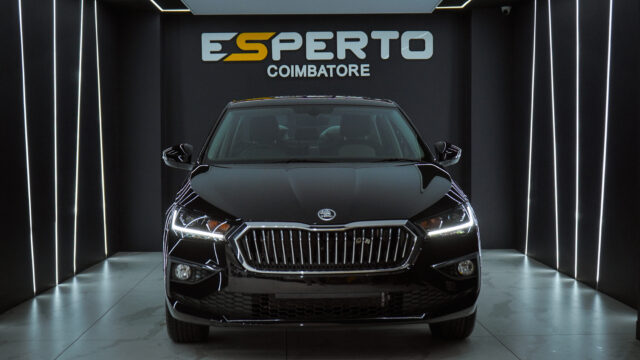
What are the different types of car wraps?
Choosing the right type of car wrap can significantly change the appearance of your vehicle. Car wraps offer a way to modify your car’s look without permanent alterations.
- Full Wraps cover every external surface of the vehicle, transforming its entire appearance. People use full wraps when they want a completely new color or to apply complex graphics across their car.
- Partial Wraps focus on specific parts of the vehicle, such as the hood, roof, or doors. This option is ideal for those looking to add accents or highlight particular features without wrapping the whole car.
- Vinyl Decals are smaller pieces of vinyl applied to the car for decorative purposes or advertising. They’re perfect for adding logos, contact details, or custom designs.
- Matte Wraps give your car a modern, sleek look with a flat finish. Unlike glossy wraps, matte does not reflect light, offering a unique aesthetic.
- Glossy Wraps are used to give a vehicle a shiny, polished look that stands out. This type closely mimics the look of traditional paint and is famous for its shine.
- Satin Wraps fall between matte and glossy finishes, providing a soft sheen that enhances the car’s color without too much glare.
- Metallic Wraps include metallic flakes in the vinyl that catch light and sparkle, offering depth to the wrap’s color and an eye-catching effect.
- Carbon Fiber Wraps mimic the look of natural carbon fiber, giving vehicles a high-tech or sporty feel often associated with racing cars.
- Chrome Wraps are highly reflective and mirror-like, making them some of the most visually striking options available for those wanting their vehicle to stand out dramatically.
- Textured Wraps such as leather or brushed metal effects offer an unusual tactile quality that can make your vehicle unique.
Each type offers different benefits and aesthetics, allowing for personalization while protecting the original paintwork beneath.
How to choose the right vinyl film
Choosing the right vinyl film is crucial for ensuring that your car’s colour wrap looks great and lasts a long time. The vinyl film acts as a protective layer for your car’s front paint job, safeguarding it against minor scratches and UV damage. Here’s how to make the best selection:
- Consider the wrap’s purpose: Decide whether you’re wrapping your car primarily for protection, style, or advertising. Advertising wraps might require different types of vinyl to accommodate vibrant designs and graphics.
- Research durability: Look for high-quality vinyl known for its durability. A good car wrap can last anywhere from three to seven years with proper care.
- Check flexibility and conformability: The vinyl should be flexible enough to conform to curves and edges without tearing or lifting. This ensures a smooth, professional-looking application.
- Evaluate removal ease: Opt for a vinyl that can be removed without damaging the car paint. Some films are more accessible to remove than others, which is essential if you plan on changing wraps frequently.
- Look at color and finish options: High-quality manufacturers offer several colors and finishes, including matte, gloss, metallic, and textured options like carbon fiber. Pick one that matches the look you want for your vehicle.
- Assess adhesive quality: The adhesive should be strong enough to hold the wrap in place but not so aggressive that it damages the paint upon removal.
- Think about maintenance needs: Some finishes may require more upkeep than others. For instance, matte or satin finishes might need unique cleaning products to maintain their look.
- Factor in installation costs: While not directly related to the film itself, consider how much professional installers charge for different types of vinyl. Specialty finishes might cost more to apply due to the extra skill or time required.
- Understand warranty coverage: Reputable brands usually offer warranties on their films covering defects like fading or cracking. Ensure you know what’s covered before making your decision.
- Go professional when in doubt: If you’re unsure about what type of vinyl film is best for your car, consult with a professional car wrap service provider who can recommend options based on your vehicle’s specific needs.
How does car wrapping compare to paint protection film?
Car wraps and paint protection films serve different purposes for vehicle aesthetics and protection. Below is a simplified comparison to help car owners and enthusiasts understand the key differences and functionalities.
| Feature | Car Wrap | Paint Protection Film (PPF) |
|---|---|---|
| Purpose | Primarily alters vehicle’s appearance. Offers a range of colors and finishes. | Focuses on protecting the car’s paint from scratches, chips, and UV light. |
| Material | Made from vinyl. | Clear, thermoplastic urethane film. |
| Appearance Impact | Can drastically change car’s appearance. Options include matte, gloss, and textured finishes. | Presents an invisible layer, maintaining the original paint look. |
| Protection Level | Provides a thin layer of protection against minor scratches and UV rays. | Offers superior protection against physical damage and environmental factors. |
| Application Areas | Can cover entire vehicle or specific parts. | Typically applied to high-impact areas such as front bumper, hood, and mirrors. |
| Longevity | Life span of up to 7 years with proper maintenance. | Can last 10 years or more, depending on product quality and maintenance. |
| Cost | Varies based on design complexity and coverage area. Generally less expensive than PPF. | Costs more due to its durable nature and protection level. Investment in longevity. |
This table outlines the fundamental distinctions between car wraps and paint protection films. Both have their unique set of advantages, whether your goal is to upgrade your car’s look with vinyl wraps or shield its paint with a PPF. Selecting the right option depends on your priorities, whether they’re aesthetic changes or safeguarding your vehicle’s surface against damage.
What Is the Car Wrapping Process?
The car wrapping process starts with choosing the right vinyl film for your vehicle. Experts clean and prepare the surface to ensure that your car is ready for the wrap. They carefully apply the vinyl, using a heat gun to mold it perfectly around every curve and corner of your vehicle.
This step requires precision to avoid air bubbles and wrinkles that can mar the appearance of your vehicle without damaging the underlying paint.
Next, technicians trim excess material and tuck edges securely. Depending on the size of the car and the complexity of the design, the entire wrapping process takes several hours to complete.
Car wraps should not damage your car’s color or finish when removed by professionals. With proper care, a wrapped vehicle enjoys enhanced aesthetics along with protection from minor scratches and UV exposure.
Moving forward, it explores how maintaining a car wrap extends its lifespan significantly.
How is vinyl film applied to the car?
Applying a car wrap transforms the look of your vehicle. This process involves a few key steps to ensure the vinyl film adheres appropriately and lasts long. Here’s how professionals at a car service provider like Esperto Car Care Coimbatore do it:
- Clean the car thoroughly. Any dirt or grease on the car’s surface can prevent the vinyl from sticking correctly.
- Measure and cut the vinyl film. Specialists measure your car and then cut the vinyl to ensure it fits perfectly and covers every curve and edge.
- Apply a primer if needed. In some cases, a primer helps the vinyl stick better, especially around complex curves or edges.
- Peel off the backing paper from the vinyl. This exposes the adhesive side that will stick to your car.
- Position the vinyl on the car. Experts carefully position the vinyl, ensuring it aligns perfectly with your vehicle’s design.
- Apply it using heat guns and squeegees. Heat makes the vinyl more flexible, while squeegees help smooth out bubbles and wrinkles for a flawless finish.
- Trim excess vinyl. Using precision tools, any extra material beyond the edges is carefully trimmed away.
- Post-installation heating is done once more after installation to ensure that all parts of the wrap are firmly attached, especially on curved surfaces where there’s a higher chance of lifting.
- Inspect for quality assurance. A thorough inspection ensures every part of your vehicle is flawlessly covered without any imperfections.
This systematic approach gives your car a new appearance while protecting its original paintwork against wear and tear from environmental factors.
What is involved in the car wrapping process?
Car wrapping involves a detailed process to transform your car’s look. Professionals use vinyl wraps to cover the vehicle’s original paint, offering both style and protection.
- Choose the suitable wrap. First, you select a vinyl film, considering texture options and colors that match your style.
- Clean the vehicle thoroughly. Before applying the wrap, workers clean your car to remove dirt and debris that might prevent the vinyl from adhering correctly.
- Remove exterior parts. Parts such as mirrors and bumpers get removed to ensure the wrap covers every part evenly without seams or bubbles.
- Measure and cut the vinyl film. Specialists measure your car and cut the vinyl precisely, ensuring it fits perfectly.
- Apply the vinyl wrap carefully on each section of the car, starting from one end and smoothing out any air bubbles as they go.
- Use heat guns to seal the deal. After applying the vinyl, experts use heat guns to help adhere it securely around curves and edges.
- Trim excess vinyl film around the edges, ensuring a neat finish without damaging the car’s paint underneath.
- Reattach removed parts once they ensure all sections are wrapped neatly; they reattach any parts that were removed at the beginning of the process.
- Perform a final inspection for air bubbles or imperfections in wrapping to ensure long-lasting quality by fixing any issues spotted during this checkup.
Each step is critical in transforming your vehicle’s appearance, giving it a fresh look while also protecting its original paintwork against everyday wear and tear.
How long does the wrapping process take?
The wrapping process can vary in time due to several factors, such as the size of the vehicle and the complexity of the wrap design. Typically, it takes about 1 to 3 days to complete a full wrap on a car.
For larger vehicles or more intricate designs, installers might need additional time.
A standard car wrap may take up to three days to complete, ensuring quality and precision in every inch of the vinyl applied.
Experts ensure that each step, from cleaning to applying and finishing, is done with the same level of care. This means many car owners will need to plan to avoid having access to their vehicles during this period.
Choosing an experienced installer can significantly affect the lifespan of the wrap and how stunning it looks on your car.
Car Wrap Maintenance and Lifespan
Maintaining a car wrap is crucial for ensuring its longevity and keeping your vehicle looking fresh. Car owners should regularly clean their vehicle wraps with soap and water to prevent dirt from building up, which can damage the vinyl over time.
Using a car cover will protect the wrap from sun damage and reduce fading. If the wrap starts showing signs of wear or the protective cover gets damaged, it’s essential to address these issues promptly to prevent further deterioration.
A typical car wrap can last between five to seven years if properly maintained. Factors like exposure to sunlight, frequency of washing, and general care play significant roles in determining the life of the car wrap work done.
Vehicle wraps are not just used to change a car’s color or design; they also act as a protective layer against minor scratches and UV rays. Extending the lifespan of your vehicle’s aesthetic appeal through vehicle wrapping doesn’t require extensive effort but demands consistent care.
Next, let’s explore how removing a car wrap works.
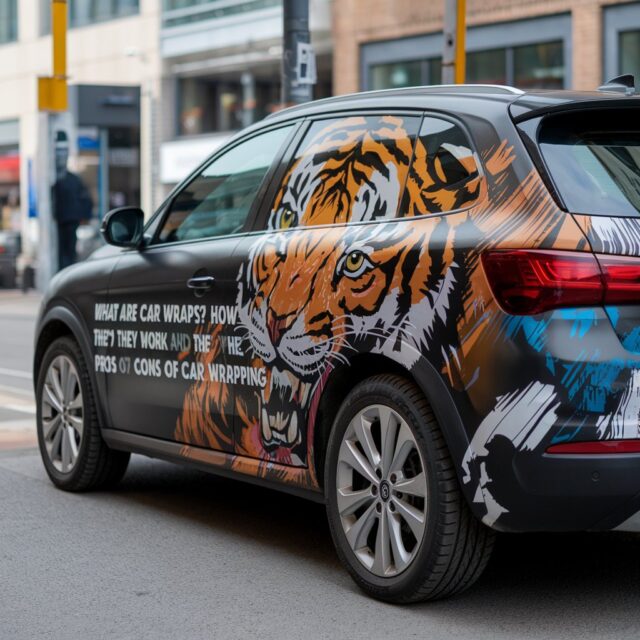
How to maintain a car wrap
Maintaining a car wrap properly extends its lifespan and keeps your vehicle looking sharp. Regular upkeep ensures the vinyl film remains vibrant and protects the paint underneath. Here’s how to care for your wrapped vehicle:
- Wash regularly by hand using mild, non-abrasive soap and water. High-pressure washers can lift the edges of the wrap, so it’s best to avoid them.
- Always use a soft, clean cloth or a sponge to prevent scratches on the vinyl surface.
- Apply wax or sealant specifically designed for vinyl vehicle wraps at least once every three months. This adds an extra layer of protection against UV rays and environmental contaminants.
- Store your car under a car cover or in a garage when not in use. Prolonged exposure to the sun can fade the wrap over time.
- Spot clean spills and stains immediately to prevent them from settling in. Gentle cleaners work best; avoid solvents that can damage the wrap.
- Inspect your wrap often for signs of wear, like lifting edges or minor tears. Early detection allows for prompt repair before issues escalate.
- Avoid parking near sprinklers, as water spots can leave mineral deposits on the wrap, which are difficult to remove once dried.
- If you notice vinyl starts peeling, take your vehicle to a professional installer for repairs instead of trying to fix it yourself, which could cause further damage.
- Use only microfiber towels when drying your wrapped car after washing to avoid leaving swirl marks or scratches on the surface.
- Keep sharp objects and abrasive materials away from your car’s surface to prevent accidental punctures or scrapes on the wrap.
What do you do if the wrap is damaged?
After thoroughly covering how to maintain your car wrap, an inevitable question arises: what actions should you take if the vehicle wrap gets damaged? Damage can range from minor scratches to significant tears, affecting both the aesthetics and protection of your vehicle wrap.
Detecting damage early is crucial for swift repairs. If you find a small scratch or peel on your vinyl wrap, don’t delay addressing it. Contacting professional vinyl wrap installers as soon as possible can prevent further damage and potentially save costs on extensive repairs.
Professionals have the right tools and expertise to assess whether a simple patch will suffice or if a more extensive section requires replacing. They also ensure that removing a vinyl wrap does not harm any underlying paint.
Wrap longevity heavily depends on initial installation quality and maintenance; thus, choosing reputable professionals for both application and repair ensures your car’s cover lasts its expected lifespan.
Regular checks keep minor issues from turning into big problems.
How long does a car wrap last?
A car wrap typically lasts 5 to 7 years. However, this lifespan can vary depending on several factors, such as the quality of the vinyl film used, how well the various vinyl vehicle wraps areare maintained, and the environment to which they are exposed.
High-quality wraps tend to have a longer life because they’re more durable against weather conditions, scratches, and fading. Regular maintenance, such as keeping the part wrapping a car clean and using a car cover to protect it from harsh weather, can also extend its life.
To ensure you get the most out of your wrap, choose a high-grade vinyl film and follow a consistent maintenance routine. Minor damages on the wrap should be fixed promptly before they grow into more significant issues that could affect its overall longevity.
Keeping these practices in mind will help maintain your vehicle’s aesthetic appeal while ensuring that your investment in wrapping is worthwhile.
Conclusion
Shifting focus from the endurance of car wraps, it’s beneficial for automobile owners, enthusiasts, and motorbike fans to be well-informed about what car and vehicle wraps are and how they are detailed. Car wrap services provide a distinct method to rejuvenate the appearance of your automobile while preserving its original paintwork.
Opting for a personalized wrap permits you to select from an array of vinyl film variants that align with your style or transform your vehicle into a mobile billboard. Nevertheless, like any investment in your vehicle’s image, contemplating the merits, costs, and demerits is crucial.
The selection of an ideal wrap involves balancing elements such as expense versus durability and the effect on resale value. Superior wraps have the potential to last several years and defend against minor scrapes and UV harm. Yet, subpar installation or inferior materials might result in signs of wear or color loss.
Grasping these parameters aids in ensuring that your decision to wrap your vehicle not only elevates its look but also possibly it’s worth. Regular upkeep ensures that the wrap’s lifetime meets or surpasses predictions, making it a desirable choice for those wishing to modify their vehicle’s look without making a permanent statement, partially covering it with paint.


